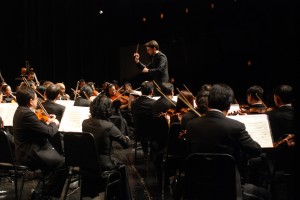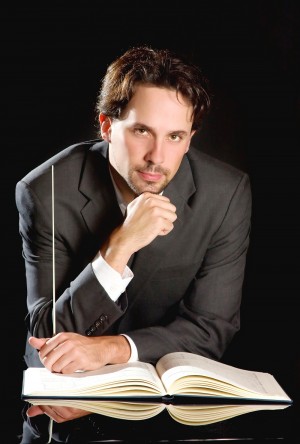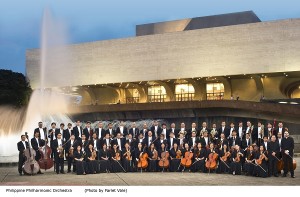A personal journey with classical music

Chilean flutist Viviana Guzman enthralls the crowd during PPO’s 31st season opener “Guzman & The Pathetique”. CONTRIBUTED PHOTO/Orly Daquipil
MANILA, Philippines—Courtesy of my long-departed, dearly missed college professor Jess Q. Cruz, I have been introduced to classical music via the Philippine Philharmonic Orchestra (PPO) a couple of decades ago.
He was then writing a column on the performing arts for a national daily and he’d tag along students willing to watch the shows if only to experience live what he’s been lecturing about in our Humanities classes. We’d know there’s a big difference between Baroque and Classical. If he’s talking about Modern Music, it’s not U2 or the Rolling Stones.
Back then the PPO was only on its 10th season and we’re one of those angry long-haired kids who’d rather follow campus gigs of Wolfgang, Razorback, The Dawn, Afterimage and the Eraserheads than brave rush-hour traffic from the University Belt to the CCP Complex.
But good music is good music and every song or musical composition stems from the urge to share a story, a special moment or an emotion, so I learned over the years.
From rock to classical
At any rate, there were days for heavy metal rock or what’s then called alternative music and there was just only one Friday or Saturday night in a month for the PPO. The well-blended sound of violins and violas, the flutes and trumpets, the timpanis and drums would fill our brains and calm our nerves after several nights of eardrum-splitting gigs in smoke-filled the louder-the-better bars in Sampaloc, Manila or along Edsa Cubao.
Now the situation didn’t change at all. It’s as if the 1990s are back, the same way oldtimers would say back then the ‘70s are here again. Now rock bands are very much alive. The Eraserheads are back touring the world while each member maintains his own successful career. Wolfgang is touring the Philippines via a local liquor company-sponsored music fest. The Dawn is still rockin’ despite vocalist Jett Pangan creating a successful career in theater. Rock stars like Chito Miranda of Parokya Ni Edgar are very much in the news, if only not for his music but something “rakenrol,” as how Pepe Smith would term it.
Over the years, chamber music and rock bands have jammed together. In 2006 there was Rockestra concerts, which had The Dawn, Up Dharma Down, Itchyworms, Sandwich and other bands jamming with the Manila Symphony Orchestra.
There have been no boundaries ever since.
PPO’s 31st season
Amid it all, the PPO survived and has just opened its 31st season with a show titled “Guzman & The Pathetique” on September 6.
At the helm was Maestro Olivier Ochanine, PPO conductor and music director since 2010.
The featured guest was Chilean-born flutist, Viviana Guzman, who The New York Times described “an imaginative artist.”
Based on the program notes, Guzman is a traveling musician, performing around 80 concerts in a year all over the world.
She started musical training at the age of five and since then has performed with various orchestras in the world and in prestigious venues like the Carnegie Hall. Besides the Lincoln Center Scholarship, she’s been awarded with Phillips Foundation Award, Institute of Hispanic Culture Award, among others.
Guzman has recorded eight albums, including “Planet Flute,” “Mostly Tango,” and Danza de Amor”. Dabbling into poetry, she has published a collection titled “Love Soliloquies” under Syren Press.
Kate Winslet is a fan who openly told her how she loved her music. Author Isabel Allende declared her music is “celestial.”
It was one of those rainy nights where traffic to the CCP seemed unbearable but it’s all worth it.
The program for the first half includes Paul Dukas (1865-1935) “Fanfare For La Peri,” and Franz Liszt’s (1811-1886) “Les Preludes” followed by Antonio Vivaldi’s (1678-1741) “Flute Concerto in D Major”.
Flutes of the World
The highlight was Guzman playing Vittorino Monti’s (1868-1922) “Czardas” and her own work, the amazing and delightful “Flutes of the World”.
“Fanfare” is from the ballet in one act, “La Peri,” or “The Flower of Immortality”. As we said, in every musical composition there’s a story to be told, and this one focuses on a character named Iskandar searching for immortality and his encounter with the elusive flower.
Reading the program notes written by David Jerome Johnson, co-founder of the Clarion Chamber Ensemble and presenter of the weekly 98.7 FM DZFE Classical Radio Show “Chamber Music In Progress,” we discovered how Liszt came up with “Les Preludes, Symphonic Poem No. 3, After Lamartine.”
The background story gives us a glimpse on how this great composer’s mind works.
As how it is called, the symphony was inspired by the four poems of French poet Joseph Autran, which had something to do with wind, earth, water and the stars. The original version is titled “Les Quatre Elemens (The Four Elements)”, an Overture to a yet to be published Choral work.
But as Johnson wrote: “Liszt began to contemplate orchestrating the four poems only after he discovered a long meditative poem by French writer Alphonse de Lamartine, which evoked emotions similar to what Liszt envisioned in his music. It was from the title of Lamartine’s poem, “Les Preludes”, which Lizst took the name for his piece.”
It is but delightful to know how Liszt was inspired by the poems he read. Nowadays, we’d be equally thrilled to hear of any Filipino composer, even rockers when they are pressured to produce a piece for an album, inspired by reading the evocative works of our contemporary poets like Joel Toledo or the veterans like Gemino Abad.
We know multi-disciplined artist, Khavn dela Cruz, putting music into poems he wrote and published, though most of them are love songs, about a thousand of them as of this writing. We’re also aware of modern icon Lourd de Veyra’s works though he himself categorized his songs for Radioactive Sago Project as “spoken word” put into music.
At any rate, Liszt is The Man, the idol of idols. Johnson further wrote: “In creating his symphonic poems, Liszt took novel idea floating in the literary sphere and created music that was imaginative, distinctive and compelling.”
Johnson added: “The 13 Symphonic Poems of the Lizst canon provided the models for Smetana’s ‘Ma Vlast,’ Tchaikovsky’s ‘Romeo and Juliet,’ Dvorak’s entire ‘Legends’ cycle and Richard Strauss’s ‘Death and Transfiguration.’ Without ‘Les Prelude’ in particular these works might not have been imagined.”
Vivaldi’s “Concerto in D Major’ for flute, strings and continuo, RV. 428” is considered a gem of the baroque era. It belonged to the Flute Concertos that Vivaldi wrote when his career was about to reach its peak. The Flute Concertos was also considered the first set of concertos ever published.
Johnson wrote: “The opening ‘Allegro’ is as light and effervescent as the opening of ‘Spring’ from the ‘Four Seasons’ reminding the listener of the beauty and purpose of exploring a riveting landscape. The central ‘Cantabile’ is as warm and crystalline as a lovely aria from a pastorale. The closing ‘Allegro,’ reminiscent of a finale from a divertimento, presents as a vigorous and energetic dance”
All this Miss Guzman performed like a charming gypsy Latina temptress we were reminded of La Esmeralda in that Victor Hugo’s book. But we’re all Quasimodos in her presence.
Incidentally the good news is that Vivaldi’s “Four Seasons” is included in the 2013-2014 PPO season. Several months ago, Maestro Ochanine posted on his Facebook account a survey on what people want to hear for PPO’s 31st Season and no pun intended, “Four Seasons” was among the top choices so finally due to insistent public demand, it will be finally performed on January 18, 2014.
(But prior to that, PPO performs a program of Filipino works under the baton of PPO Associate Conductor Herminigildo Ranera on October 11, 8 p.m. at the CCP Main Theater.
Titled “Mostly Filipino,” the concert features Angel Peña’s “Philippine Festival Overture,” Alfredo Buenaventura’s “Manik Buangsi and Tuan Putli Symphonic Poem,” Lucio San Pedro’s “Buan sa Kabundukan,” and Felipe Padilla de Leon’s “Manila Sketches”. Also on the program are “La Création du Monde” of Darius Milhaud and “Slavonic Dances Nos. 1-8 Op.48” of Antonin Dvorak.)
After performing Dukas, Liszt and Vivaldi pieces, Miss Guzman received around five to six-minute standing ovation. About a dozen members of the PPO who accompanied her went out of the stage with her and Maestro Ochanine.
Amid the resounding applause, she went back with a table full of what looked like flutes of different sizes.
And here’s the major highlight as Guzman performed her “Flutes of the World.” As the term suggested, the audience members were treated to the sound of different kinds of flutes representing various cultures.
She was accompanied by about five percussionists from the PPO, mostly for the background ambient music.
There was the native American Indian Flute, described “an end-blown flute fashioned either from cane, hardwood like walnut or softwood like cedar.”
Its deep, resonating sound is expectedly tribal, like those we hear in movies as old as American Westerns featuring the Indians.
At this point, the statuesque Miss Guzman appealed to us like Pocahontas in gold-colored cocktail dress.
Probably the oldest instrument was the Swiss Gemshorn, described the only medieval flute with a sharply tapering conical bore. “Its shape is determined naturally since it is made from the horn of a chamois or ox. Shepherds probably used its gentle tones to calm animals.”
With the Chilean Zampona, a traditional Andean panpipe, she performed a tango. It was a delight to see Chilean Ambassador to the Philippines Roberto Mayorga and his wife Paulina in the audience. Miss Guzman credited them for playing hosts in her stay in Manila.
There was the Hungarian Fuvola, a long thin tube with no single tone hole. Miss Guzman teased the audience how many notes she could play with a flute with no tone holes. But we were surprised when she played a popular folk tune whose title escaped us now. Though a bit far-fetched geographically but I was so charmed by its music I felt like one of the rats following the Pied Piper of Hamelin.
There was the Irish Tin Whistle, also called the Penny Whistle, a simple, six-holed woodwind instrument. Naturally it is said to be associated with Celtic music and we’re like sheeps in the highlands of Ireland upon hearing it. Although we’ve never been there physically, only through simulated experiences via movies we watched.
The most delicate of all was the Chinese Ditzi, a side blown flute. It is made of jade and it has to be housed in its case all the time, only to be removed from it to be played. Again, we’re transported to Imperial China in the younger days of Henry Pu-yi.
A major surprise was the inclusion of the Philippine bamboo flute, whose sound we’re all familiar with. The foreign dignitaries and some expats in the audience were treated to the sound of our native highlanders. Miss Guzman chided the audience that she was advised not to play it during allergy season.
She was supposed to play Vittorino Monti’s “Czardas” before “Flutes of the World,” but she changed the program by performing this for her final piece.
Then again, the audience asked for more and she obliged with about two or three encores. It seemed no one wanted her to go as she received a 10-minute standing ovation.
But trips to the comfort room seemed necessary so the 15-minute intermission was declared.
Together with other guests unable to function without nicotine in the bloodstream, my partner and I took a quick cigarette break outside and gazed at the lighted CCP fountain.
Tchaikovsky’s ‘Pathetique’
We saw veteran culture writer Amadis Ma. Guerrero walking out of the venue. I caught up with him before he went down the elevated parkway of the CCP façade.

Maestro Olivier Ochanine leading the PPO for Peter Illyich Tchaikovsky’s “The Pathetique”. CONTRIBUTED PHOTO/ Orly Daquipil
I asked him why he’s going home already and not hear the second half of the show, featuring Peter Illyich Tchaikovsky’s “Symphony number 6 in B Minor ‘Pathetic’ Opus 74 (1893).” The program notes told us it premiered on October 28, 1893 at St. Petersburg, about 120 years ago.
“It’s depressing, I don’t like that piece of Tchaikovsky,” Amadis told me with a smile and bid me goodluck and goodbye.
Considered the most loved and best known of all Russian composers, I was reminded of his most famous works like, of course, the perennial Christmas favorite performance piece of Ballet Philippines, “The Nutcracker Suite.”
I thought I might give it a try. I read from the program notes how Tchaikovsky described “The Pathetique” in a letter to his long-time benefactor, Madame Von Meck how he poured his soul into the work. “I often wept bitterly while composing it, I love it as I have never loved before any of my musical offspring, it is the best thing I have ever composed or shall ever compose,” Tchaikovsky wrote.
It began the adagio-allegro with the sound of a lone bassoon, setting the mood, followed by the viola section repeating the same cycle of notes. And suddenly I am in a war movie and it’s a winter scene after a battle, with dead soldiers and a lone wounded survivor is scampering for food among the ruins. Yes, it’s hauntingly depressing.
Five minutes into it and I fall asleep, awakened once in a while by the sound of the drums and clashing cymbals. But all throughout the 60-minute “Pathetique” I had the best nap for the day. I was thankful because I haven’t had a decent sleep for week since my regular work required me to adjust to the night shift.
Music indeed has its unique way of calming us humans.
On our way out after a resounding applause, my partner told me it’s like she was reading again the works of Dostoevsky and Leo Tolstoy.
I felt pathetic for falling asleep and I guess by that time, Amadis was also in deep slumber at the comfort of his bedroom.
RELATED STORY:

